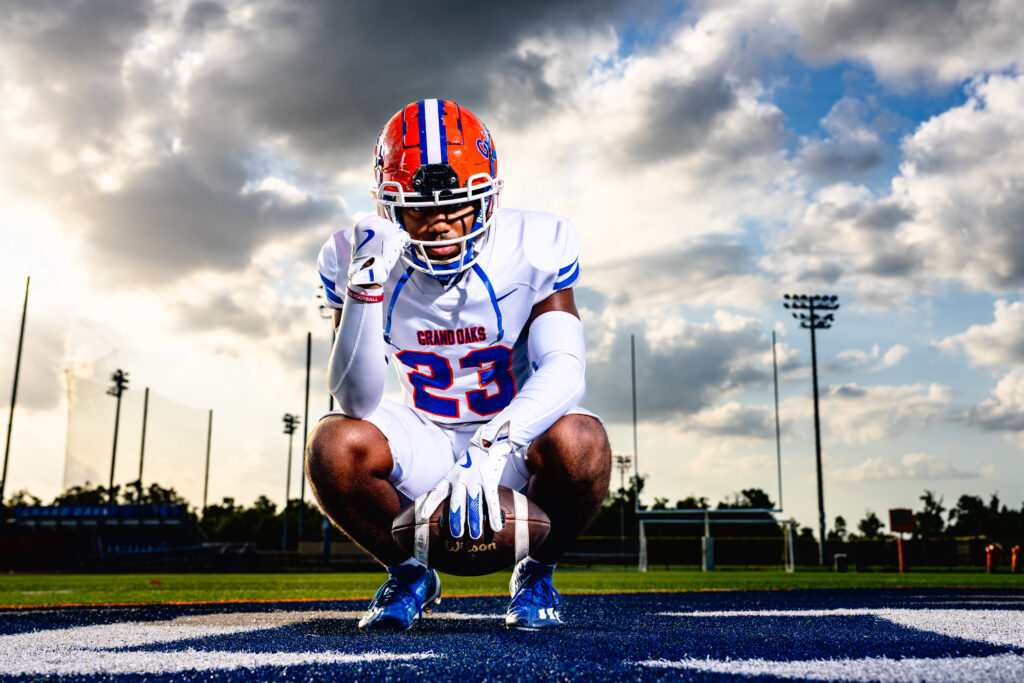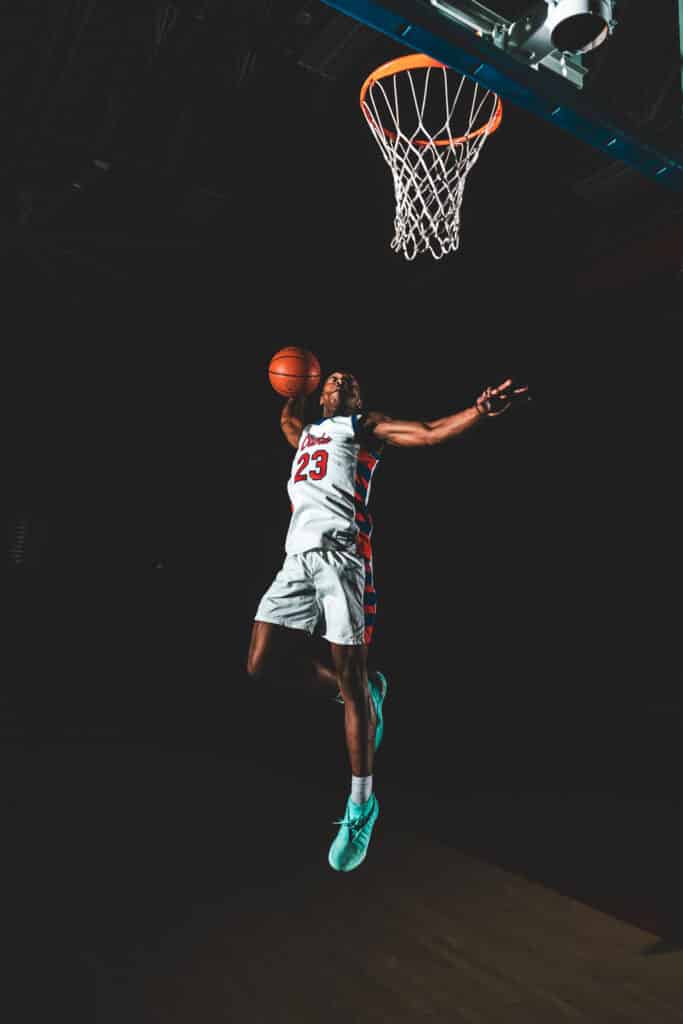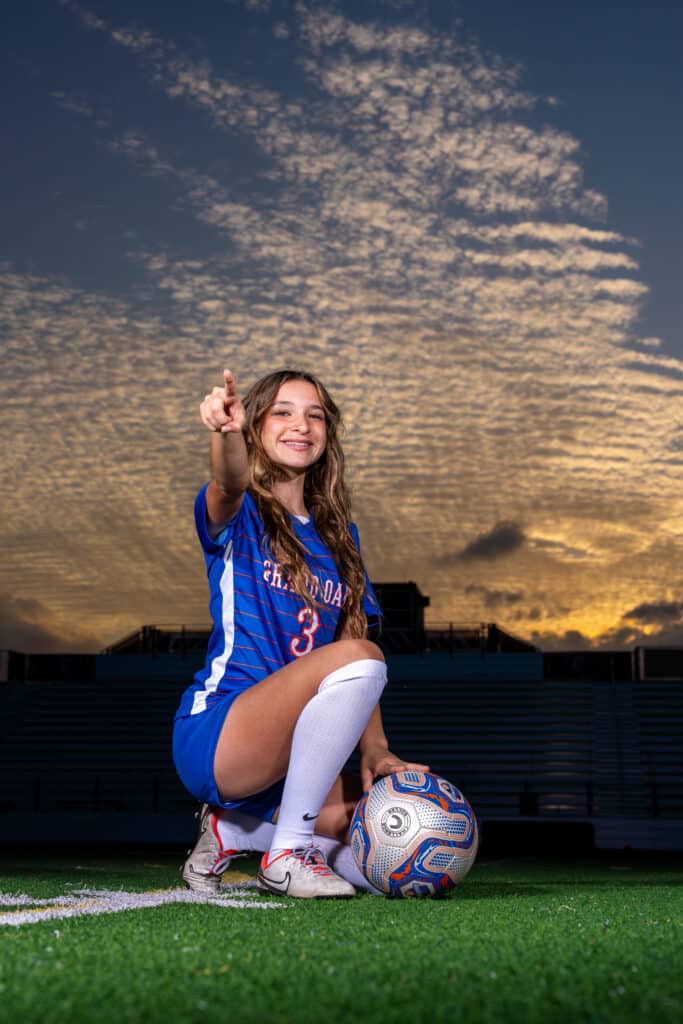Essential gear and apps for school sports photography: From action shots to team photos.
Photographing school sports has its own set of challenges. Beyond knowing your camera and having a solid understanding of the impact shutter speed and aperture will have on your shots, it is helpful to have an understanding of the sport so you can predict the flow and movement of the players and which moments are the most dynamic.
School sports photography is also different from niches like weddings and newborn portraits in that your clients may be the school, the parents and students, or–more often than not–both. As a school sports photographer, these parties value your ability to capture feats of student athleticism in action and dynamic team and individual portraits. Your images can enhance the school websites and yearbooks, student or local newspapers, be shared on student and parent social media profiles, or even become part of a promising athlete’s scholarship application.
14-day free trial. No credit card required.


Success in school sports photography comes down to equal parts preparation before the shoot and quick thinking once the action starts. Keep reading for insights into the gear, apps, and mindset required to consistently deliver exceptional results and become a sought-after photographer in this specialty.
We’ve included gear and accessory recommendations from Seth Fontenot, a professional school sports photographer and videographer with experience capturing more than 10 different school sports. Fontenot is known for his bold colors and use of light and shadow, sharp images, and eye for emotionally charged moments on the field, bringing that same contagious energy to his hype reels and individual athlete portraits.
Capture every play: Cameras and lenses for action photography.
When it comes to school sports photography, having the right gear is essential to your success as an action photographer. Your equipment needs the capability to adapt with you to manage factors like fast-moving subjects and low-light conditions, which can make or break the capture of a live sports event. Below are camera and lens suggestions for capturing that coveted tie-breaker action shot.
Essential Sports Photography Gear:
- Cameras: Fast, high-performing DSLR or mirrorless cameras like Canon R6, Nikon Z9, or Sony A1
- Lenses: Telephoto lenses such as 70-200mm f/2.8 or 100-400mm for action shots
In pro photographer Seth Fontenot’s camera bag:
- Sony A9iii & A7RV
- 300 2.8 GM, 70-200 2.8 GMII, 24-70 2.8 GMII, 1.4xTC
- 35mm 1.8, 135mm 1.8, 14mm 2.8
He also shared a few things to consider when buying gear:
- Use a full-frame camera with a high frame rate to freeze the action
- Choose lenses with f/2.8 (or better) for tackling low-light conditions
Pro tip: prioritize fast autofocus and high burst rates for tracking athletes on the court, and use wide-aperture lenses for evening games or indoor venues. The shallow depth of field makes a significant difference when capturing subjects in motion.
Must-have extras: Accessories to improve your in-session workflow.
With the basics covered, it’s time to consider helpful accessories that will take your photography game to the next level. The following gear allows you to adapt to all the different elements of a sports photography shoot, from group shots to individual shots and action shots.
When preparing to capture sports photography, here are the recommended accessories for getting that perfect shot no matter what the game might throw your way:
Essential Accessories:
- Monopods: Lightweight camera and lens support for steady shots during long games
- Rain covers: Equipment protection for outdoor games and unpredictable weather
- Extra batteries: Quick replacements when you need them most
- Memory and SSD cards: High-capacity storage for burst shooting sequences, and plenty of them
- Tablet or iPad: Handy for managing digital shoot lists and contracts, syncing with your camera using an app like CaptureOne, or quick edits.
- DataColor calibrator: Ensure great color edits no matter the lighting
Seth Fontenot’s professional kit list:
These photography accessories help with adapting to indoor and outdoor conditions, adding lighting effects, and managing heavy photography equipment:
- Strobes: Godox AD400 (x4), Godox AD300 Pro, Godox MS300 (x2)
- Speaker: Samsung MX-ST50B
- Fog: American DJ 1300 and Atmosphere Aerosol Cans
- Cargo Cart: Gator 52″ Utility Cart Standard
Memory cards are particularly important for sports photography because the action-packed nature of the subject matter calls for high burst rates, requiring larger digital storage capacity than other types of photography like portraiture.

Work smarter, not harder: Apps to streamline and enhance your photography.
The reality of being a photographer is that you need to read the environment around you and adjust your equipment accordingly multiple times during your shoot. Thankfully, today there are multiple digital tools designed to lift some of the photographer’s mental load. Here are the best apps for sports photographers, covering everything from booking clients to post-editing from your smartphone.
Essential tools and apps for busy photographers:
- On-the-go mobile editing apps: Lightroom Mobile or Snapseed for quick edits
- Sports-Specific Apps: Athlete tracker apps for schedules and stats
- Business management apps: digital contracts with services like Studio Ninja or HoneyBook–trust us, you want to avoid storing and keeping track of all those paper copies.
- Culling tools: narrow down the hundreds of images you shot during the your most recent sports event or team photos with sorting and culling tools like PhotoRefine or PhotoMechanic
- Broad edits: After culling, use a tool like Lightroom to take advantage of AI Denoise on the low light grainy shots and AI masking of subjects, background, or sky.
- Fine edits: Editing tools like Photoshop not only have additional background removal and generative AI options for images that need a different crop ratio, but also integrate with plugins
- Plugins & workflows: plugins like Pixnub offer a variety of workflows with AI features tailored specifically for school and sports photographers.
Seth’s pro tip: Sports Pro Automation, Image Extract, and EZ Team Builder are automation workflows in the Pixnub plugin useful for batch editing school and sport templates. They allow you to swap images and modify text without creating a new PSD file each time. You can also use their AI features to automate background removal and creation of team compilations.
With modern digital tools and apps available for everything from client management to mobile editing, photographers can now streamline their workflow and focus more on capturing the perfect shot rather than getting bogged down by technical and administrative tasks.
Gear maintenance and backup tools: Keep your files and equipment safe and ready for every shoot.
Now comes the essential but less exciting part of being a photographer: digital storage and gear maintenance. While they’re not the most thrilling aspects of the job, regularly tending to these two elements can prevent major issues down the road.
Here are better-safe-than-sorry maintenance and backup tips every sports photographer should know:
- Cleaning: Regularly clean lenses and camera sensors for optimal clarity. Kits can be purchased for this purpose, useful for unplanned grime during a shoot and weekly–or after every shoot as needed.
- Gear maintenance: Major camera brands offer paid plans for regular maintenance of your camera and lenses–compared to having an unexpected issue during a shoot, paying a few hundred a year to have your gear checked annually is worth its weight in…well, camera gear that works!
- Physical Storage: Use external SSDs or hard drives for immediate backups. These can be costly depending on storage size, but you only need to buy them once.
- Cloud Storage: Secure your work using online storage solutions like BackBlaze, and be sure to read the fine print. Only use fully encrypted platforms to ensure the safety of your work and your clients’ privacy.
If you dislike this part of the job, schedule a 30-minute end-of-week or end-of-month backup session–you can clean your gear while you wait! Alternatively, many services also offer automatic backup options, so you can include backup to your external drives as part of your workflow and include them in your automated cloud storage backup to keep your photos secure. Apply the same principle as with batteries and memory cards: keep them charged, backed up, formatted regularly, and replaced within their expected life span–better safe than sorry!

Overcome lighting challenges: Gear and app recommendations for low-light team photos and indoor games.
Lighting can be a photographer’s best friend if you know how to work with it, but lack of preparation can derail an entire shoot. Lack of preparation and knowledge of the sport and type of location can result in blurry action shots, unhappy clients, and a missed opportunity for print or digital orders from parents–not to mention what it can do to the professional reputation you’re building.
If you’re not already, get familiar with the types of locations and lighting you can expect when covering different sports. The color and diffusion of the light at an indoor pool for a swim meet is completely different from gymnasium light for basketball or volleyball–although both will offer more consistency than the planning required for outdoor lighting and weather with sports like football, soccer, or tennis.
Essential tips for low-light photography:
- Use fast lenses (f/2.8 or wider) to maximize light intake
- Set your camera to higher ISO settings for better exposure
- Bring portable LED lights for sideline portraits or team photos
If your typical shooting location is prone to inclement weather, or if the sport is played entirely indoors, consider investing in additional lighting options that can make a humble school gymnasium look like a professional stadium. Always collaborate with the school athletic director and/or coaches to determine whether additional lights can be used during a game or event, and where you can safely place them.
If you also offer team and individual photos, your lighting equipment will allow you to create well-lit, dynamic images in any location. On the fence about lighting? Ask yourself; if I were a parent or highschool student, would I be more excited to buy photos with regular gym lighting or photos where I practically look like a college athlete?
Strobes, such as a set including Seth’s favorite Godox AD400, Godox AD300 Pro, and Godox MS300, are a professional lighting equipment option that can cost $500-$800 each. We get it–this can be a significant investment for photographers just starting out. You can add it to your wish list and start off without it, look for refurbished gear, or rent it from a nearby camera store to test it out before breaking the bank.
Successfully solving lighting challenges often requires multiple pieces of gear. Apps can also help minimize headaches and make a lighting plan before and during shoots:
- Light meter apps help check lighting conditions without leaving your spot
- Weather apps help prepare for outdoor conditions that might require different lenses and ISO settings
- Suntracker apps can help you plan the shooting direction for longer outdoor team and individual shoots in unfamiliar locations.
- Apps that sync with your lighting equipment make it easier to control and adjust settings from your phone or tablet.
Location scouting is a good idea whenever possible–and when photographing a new sport for the first time, we recommend attending a few games so you can test the lighting and learn the flow of the athlete’s movements. Proper preparation for lighting and the ability to identify what comes before the action allows you to get in place and deliver clear shots that capture the dynamic energy of the sport.

Budget-friendly alternatives: Great results without breaking the bank.
You certainly don’t need every tool we’ve listed here to get started in school sports photography. This is a great niche to photograph if you enjoy sports, working with kids, and a fast-paced shooting environment. If you have a camera body you love, you could even begin with adding a zoom lens to your bag–or renting a few different ones until you find what suits your needs. Expensive gear is not a replacement for putting in the time to practice and get better at something new.
When starting out and building your portfolio, we recommend attending and photographing sports events at local schools on your own time, or reaching out to community sports leagues about their photography needs, which can offer a low-pressure way to meet parents, sports boosters, and coaches.
Budget-friendly gear recommendations:
- Cameras: Start with mid-range options like Canon EOS R50 or Nikon Z50, or refurbished camera bodies on the higher-range gear.
- Lenses: Once you are sure which camera brand you like best, invest in 2.8 or lower aperture zoom and prime lenses within your budget that will give you a good range; a 24-70, 70-200, and 300mm will give you a lot of options.
- Apps: Search for free or low-cost options for editing and management, such as darktable
With time, you’ll learn what gear you prefer for different lighting conditions and can revisit your equipment inventory with new insight. Selling underutilized equipment to another photographer in your community or online is a great way to make connections while earning funds to upgrade the equipment you can’t live without.
Turn your images into income.
Sell your photos online from your own custom store. Set up is quick and your clients will enjoy a seamless shopping experience.
Delivering photos fast and professionally: Zenfolio client galleries.
When the last export is complete, the handoff process is the final step between you and the clients. It’s important to have an option that is both secure–remember, these athletes are usually minors–and easy to navigate. After all, you’ve put significant effort into perfecting these photos; you want the client experience to be one more thing they rave about after seeing the images.
In Zenfolio client galleries, images can be uploaded by gallery or by folder structure, making the bigger shoots a breeze and helping you keep various schools and sports organized as you grow. With multiple options for sharing–from email invites to texts to QR codes–and the ability to customize the design, add a secure password, sell digital and physical photo projects, and more, client galleries can make photo delivery the easiest part of your job.

Simplify scheduling and selling packages with Zenfolio.
Being a photographer running your own business means wearing a lot of hats. You’re juggling schedules, handling orders, and spending more time behind a computer screen than you ever thought possible. After nearly 20 years of supporting photographers, we know the challenges you face—both the ones that have been around forever and the new ones brought on by AI and ever-improving smartphone cameras. But one thing hasn’t changed: the need for a solid workflow to keep your business running smoothly—and making that easier for you has always been our goal.
Having a streamlined booking system is a game-changer. Included in ProSuite plans and as an add-on for PortfolioPlus plan, you get a built-in booking and scheduling tool, making it easy to manage individual player slots or specialty add-ons like hype and highlight reels. You can add booking blocks or buttons directly to your website, so clients can secure a spot without all the back-and-forth emailing or calls.
When it comes to selling your work, customizable print and digital packages give you flexibility and control over how you offer images to clients—whether as part of a service package or as separate purchases through your gallery. And if you are not already using the Smart Upsell feature, take a few moments to enable it! By offering clients tiered or quantity-based discounts while right in the cart, most photographers are doubling their average order totals.
Popular products to include in packages for school sports photography clients:
- Team photos
- Individual athlete portraits
- Personalized templates featuring team and individual photos
- Highlight reels from the season
When selling through your Zenfolio gallery store, you can accept payments online by card, Apple Pay, Google Pay, and PayPal–no invoices for you to create, no paper order forms to keep track of.
Success in school sports photography has a lot of factors and won’t happen overnight. But by taking the time to practice and find the right combination of gear, apps, and accessories, you’ll be well on your way. With the array of tools and technologies available today, sports photographers can streamline their workflow and spend more time out on the field capturing the action–those game-winning shots won’t photograph themselves!
Build an online portfolio website you love.
Put your sports photography in the spotlight.

